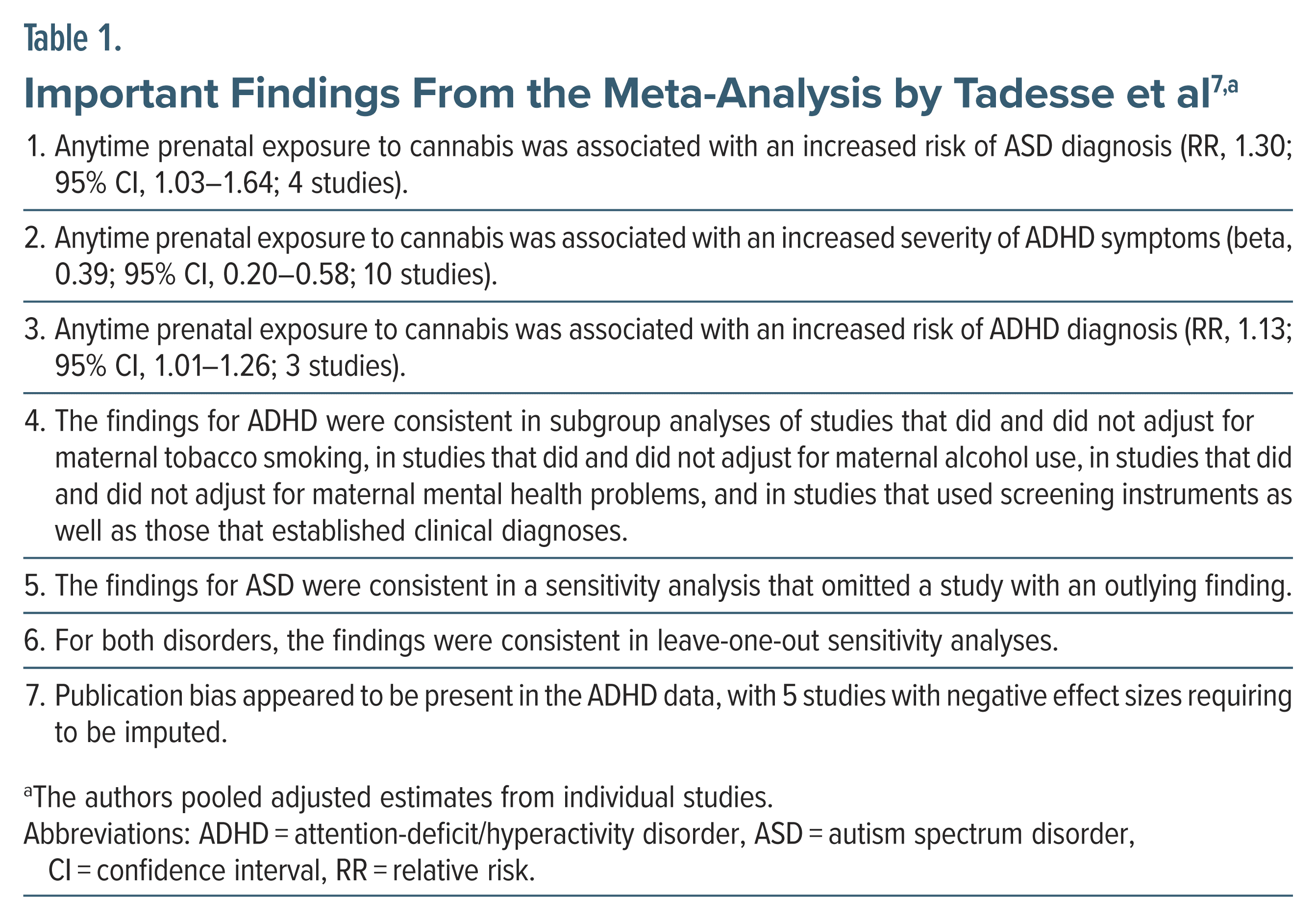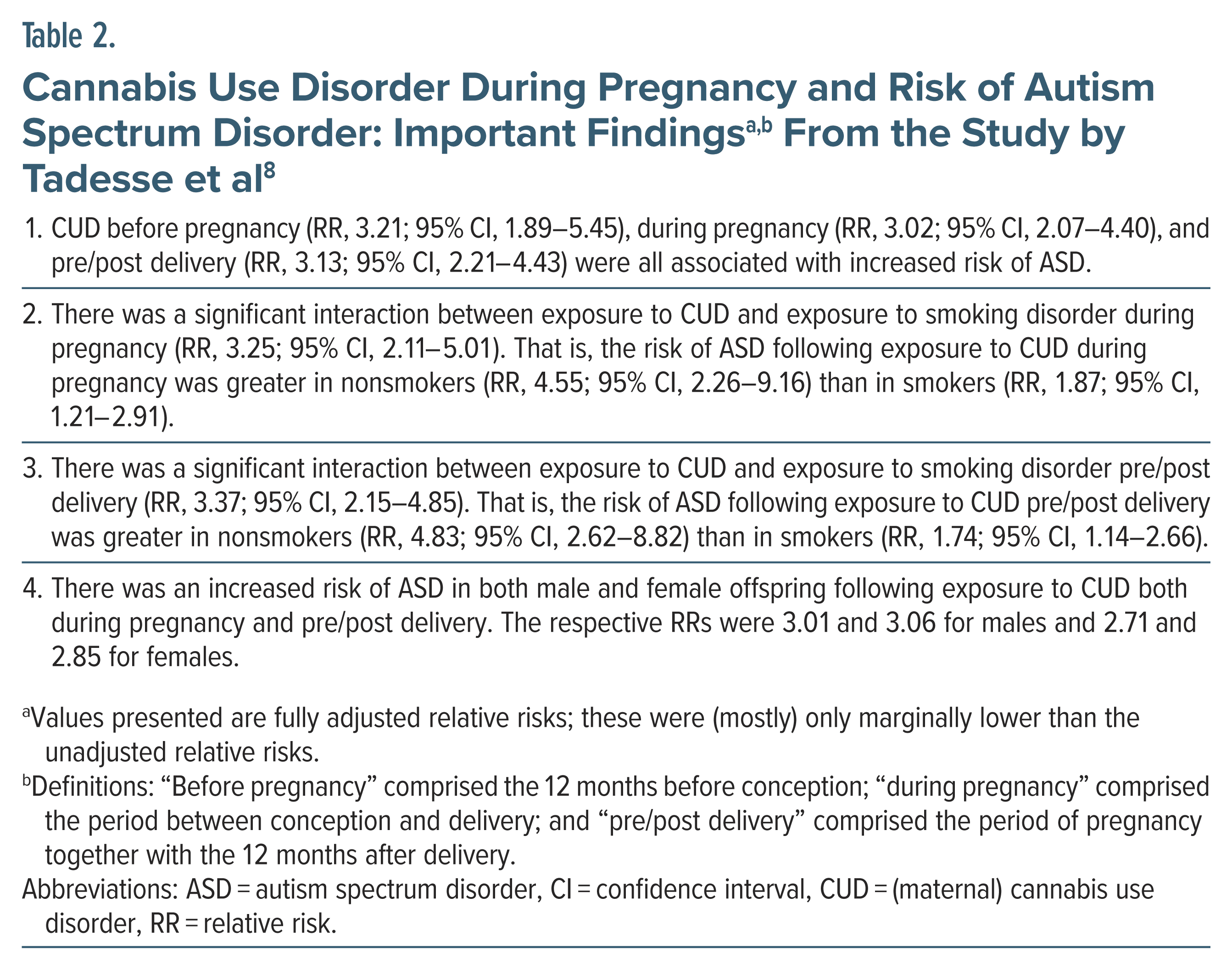Abstract
Up to 10% of women may use cannabis during pregnancy; this is of concern because constituents of cannabis cross the placental barrier and potentially influence neurodevelopment by acting on cannabinoid receptors in the developing fetal brain. In this context, a recent meta analysis of 13 observational studies found that gestational exposure to cannabis was associated with a small increase in the risk of autism spectrum disorder (ASD; relative risk [RR], 1.30) and with an even smaller increase in the risk of attention deficit/hyperactivity disorder (ADHD; RR, 1.13); the latter finding was probably supported by publication bias. In this meta-analysis, 4 studies provided information on ASD (pooled N = 178,565) and 10 on ADHD (pooled N = 203,783). In a large (n = 222,534) retrospectively ascertained cohort study published after the meta-analysis, cannabis use disorder (CUD) recorded before pregnancy, during pregnancy, and during pregnancy plus the year after delivery were associated with closely similar increased risks of ASD (RRs, 3.02–3.21). The risks were smaller in smokers (RRs, 1.74–1.87) than in nonsmokers (RRs, 4.55–4.83) but differed little between male (RRs, 3.01–3.06) and female (RRs, 2.71–2.85) offspring. Although the cohort study had many strengths, its limitations permitted only the conclusion that peri-pregnancy exposure to CUD is associated with a large increase in the risk of ASD in offspring; it remained possible that much of the risk was driven by genetic, environmental, or behavioral variables. The field is nascent; the total number of cannabis exposed pregnancies (with ASD and ADHD as the outcomes) in world literature is small. However, cannabis use during pregnancy is, at the very least, a clear marker for adverse neurodevelopmental outcomes, besides the adverse maternal, fetal, and neonatal outcomes identified in other studies. Healthcare providers who manage women who use cannabis during pregnancy need to be aware of these adverse outcomes.
J Clin Psychiatry 2025;86(1):24f15717
Author affiliations are listed at the end of this article.
A survey of the epidemiological literature found that up to 10% of women may use cannabis during pregnancy to address problems such as stress, anxiety, depression, nausea, vomiting, and pain; some may also use it as a lifestyle recreational choice or as a behavior driven by personality characteristics. Use is highest in the first trimester, intermediate in the second trimester, and lowest in the third trimester. Women with disabilities appear to have more favorable attitudes towards cannabis use.1
Use of cannabis by women of reproductive age, and especially during pregnancy, is of concern because cannabis has >550 constituents, including >100 phytocannabinoids, and because these constituents may adversely impact pregnancy by acting both on cannabis receptors that are abundantly present in the placenta and on tissues in the developing fetus.1 Earlier articles in this series examined gestational exposure to cannabis and maternal adverse outcomes, fetal adverse outcomes, and birth defects in offspring.1,2 This article examines gestational exposure to cannabis and neurodevelopmental disorders; more specifically, autism spectrum disorder (ASD) and attention-deficit/hyperactivity disorder (ADHD).
Mechanisms
Possible mechanisms whereby gestational exposure to cannabis may adversely influence pregnancy outcomes were discussed in an earlier article.1 Specifically, constituents of cannabis that cross the placental barrier are likely to act on cannabinoid receptors in the developing fetal brain, and such action may be a neurodevelopmental teratogen that disturbs endogenous cannabinoid signaling, and more, in the fetal brain, creating vulnerabilities to disorders in postnatal life.3 In this context, a study in rhesus macaques showed that prenatal exposure to delta-9-tetrahydrocannabinol altered placental and fetal DNA methylation at genes considered relevant to ASD.4 Much research on the subject has been published; in illustration, the findings of 2 studies are presented here.
In one study, in fetal samples from human pregnancies (gestational weeks, 18–22) with and without documented evidence of prenatal exposure to marijuana, after adjustment for covariates, mRNA expression for dopamine D2 receptors was found to be reduced in the basal nucleus of the amygdala in exposed pregnancies; this finding was greater in male fetuses and was greater when marijuana exposure was greater. There were no mRNA changes for D1, D2, or CB1 receptors in the hippocampus or caudal striatum.5
As another example, in a fetal MRI study of hippocampal brain network connectivity, conducted at a mean of 32.2 weeks of gestation, prenatal exposure to cannabis (n = 26), relative to no exposure in age and sex-matched fetuses (n = 42), was associated with alterations in hippocampal connectivity with dorsolateral, medial and superior frontal, insula, anterior temporal, and posterior cingulate areas of the fetal brain. The direction of altered connectivity suggested disadvantage rather than benefit.6
ASD and ADHD: Meta-Analysis
What is the clinical evidence that prenatal exposure to cannabis perturbs neurodevelopment? This question was examined in a recent systematic review and meta analysis.7 The authors searched 6 electronic resources and databases, as well as reference lists, and identified 13 relevant studies with ASD or ADHD as outcomes (one study provided information on both). All 13 studies were observational in design. Of these studies, 4 provided information on ASD (pooled N = 178,565) and 10 on ADHD (pooled N = 203,783). Sample sizes ranged from 172 to 173,035 among the ASD studies and from 63 to 173,035 among the ADHD studies; cannabis-exposed pregnancies numbered 19 to 2,364 (total, 2,541) among the ASD studies and 12 to 2,364 (total, 3,306) among the ADHD studies. Children had been assessed at a median age of 3.75 years (range, 2 to 5 years) in the ASD studies and at a median age of 5.5 years (range, 1.5 to 12 years) in the ADHD studies.
One of the studies, with ASD as the outcome, was a case-control study; the rest were cohort studies. Nine studies had been conducted in the US, 2 in Canada, and 1 each in Australia and the Netherlands.
Important findings from the meta-analysis (adjusted relative risks [RRs]) are presented in Table 1. In summary, the meta-analysis found that anytime gestational exposure to cannabis was associated with a small increase in the risk of ASD (RR, 1.30) and with an even smaller increase in the risk of ADHD (RR, 1.13). The findings were consistent in subgroup and sensitivity analyses. The ADHD data displayed probable publication bias. A limitation of this meta-analysis7 is that, in some of the included studies, children may have been examined at too young an age for the outcome of interest to develop; this might have biased study findings towards the null.
A limitation of this meta-analysis7 is that, in some of the included studies, children may have been examined at too young an age for the outcome of interest to develop; this might have biased study findings towards the null.
Cannabis Use Disorder and ASD: Cohort Study8
In the same year as that in which their meta-analysis7 was published, the same team of authors published a large cohort study8 that examined the association between maternal cannabis use disorder (CUD) and risk of ASD in offspring. This study had not been included in the meta-analysis.
The data were drawn from linked health records in New South Wales, Australia. The sample comprised children born during 2003–2005, who were followed to the end of 2018. The mean age of mothers, at delivery, was 29.8 years. Children were born at 39.1 weeks of gestation. The mean birth weight was 3.4 kg. During follow-up (mean duration not stated), ASD diagnosis was recorded in 1,441 (0.65%) of children.
There were 3 periods for which exposure to CUD was ascertained: before pregnancy, comprising the 12 months before conception (n = 538 exposed); during pregnancy, comprising the period between conception and delivery (n = 1,319 exposed); and pre/post delivery, comprising the period of pregnancy together with the 12 months after delivery (n = 1,500 exposed).
Analyses were adjusted for a range of covariates and confounds, as relevant to the period of exposure. The covariates and confounds adjusted for included maternal variables such as age, education, occupation, socioeconomic status, parity, tobacco use disorder, stimulant use disorder, psychiatric comorbidity, diabetes, and hypertension, and child variables such as preterm birth, low birth weight, child sex, Apgar score, and birth plurality.
Important findings from the study8 are presented in Table 2. In summary, CUD before pregnancy, during pregnancy, and pre/post delivery were all associated with increased risk of ASD; the RRs were in the 3.02 to 3.21 range. The strengths of these associations were smaller in smokers (RRs, 1.74–1.87) and larger in nonsmokers (RRs, 4.55–4.83); the difference was large. The CUD-associated risk of ASD was only marginally greater in male (RRs, 3.01–3.06) than in female (RRs, 2.71–2.85) offspring.
Strengths and Limitations of the Cohort Study8
This cohort study had many important strengths. First, the sample size was larger than that in all the previous studies combined: there were 222,534 subjects in this cohort study8 and 178,565 subjects in the earlier meta-analysis.7 Larger samples yield more precise estimates. Second, the study examined exposure to a recorded diagnosis of CUD rather than exposure to cannabis use during pregnancy as ascertained by, for example, self-report. Thus, the definition of exposure was more objective. Third, the study examined risks associated with exposure during different periods related to pregnancy. Examination of risks associated with exposure before pregnancy considers whether the risks are driven by maternal or environmental characteristics rather than by the exposure, itself. Examination of risks associated with exposure during a period that includes the year after delivery takes into consideration postnatal environmental and other influences. Fourth, the study adjusted for a large number of potential risk factors, allowing a better understanding of the unique contribution of CUD to the risk of developing ASD. Last, the study examined whether the interaction between smoking and CUD influenced the risk of ASD.
The study had many important limitations. The choice of CUD as the exposure variable precluded the examination of what might be a more important clinical question: Is casual use of cannabis (not amounting to a disorder) during pregnancy a risk factor for ASD? Next, in the supplementary data, the authors clarified that there was a small degree of overlap in subjects across the “before pregnancy,” “during pregnancy,” and “pre/post delivery” categories; they did not present risks for nonoverlapping subjects. If the categories were not mutually exclusive, the ASD risks presented for these categories may be inaccurate. An additional problem is that the authors did not clarify whether pre/post delivery exposure required exposure either during or after pregnancy or both during and after pregnancy; so, interpretation of the results of these analyses is problematic. Third, analyses were adjusted for variables such as preterm birth and low birth weight, both of which are possible outcomes of cannabis exposure1 and potentially lie in the path towards risk of ASD. Variables that lie in the path between an exposure and an outcome should not be adjusted for.9 Even if preterm birth and low birth weight are merely markers for CUD and do not lie in the path between cannabis exposure and ASD, they should not have been adjusted for because, by doing so, cannabis exposure is itself being adjusted for. This adjustment, therefore, has the potential to reduce the effect size that is associated with the exposure.
Take-Home Message
Gestational exposure to cannabis is associated with a small increase in the risk of ASD and with an even smaller increase in the risk of ADHD; the latter finding may be contaminated by publication bias. Gestational exposure to CUD is associated with a large increase in the risk of ASD (this is especially evident in nonsmokers), but it is possible that much of the risk is driven by genetic, environmental, or behavioral characteristics unrelated to cannabis exposure, per se; this possibility derives from the finding that the RRs were similar whether examined in association with pre-pregnancy exposure or with exposure during and after pregnancy.
Parting Notes
All studies in the field were observational in design and so no conclusions can be drawn about cause and effect. It is possible that cannabis exposure is causal in driving the risk of neurodevelopmental disorders. It is also possible that maternal cannabis use is merely a marker for genetic and environmental risk factors for neurodevelopmental disorders in offspring. Finally, we do not know what role early childhood adversities may play in driving the risk because these are never studied and adjusted for.
The total number of cannabis-exposed pregnancies in world literature is small (with ASD and ADHD as the outcomes); thus, the field is nascent. One might expect more exposure in the coming years, given the increasing acceptance and liberalization of cannabis use in the US and across the world. One might also expect more concerns about adverse outcomes, given the increasing potency of street cannabis.
One conclusion appears beyond doubt: healthcare providers need to be alert for a multitude of maternal, fetal, neonatal, and early childhood adverse outcomes in women who use cannabis during pregnancy1,2 because cannabis use is, at the very least, a marker for these adverse outcomes.
Article Information
Published Online: December 23, 2024. https://doi.org/10.4088/JCP.24f15717
© 2024 Physicians Postgraduate Press, Inc.
To Cite: Andrade C. Maternal cannabis use in pregnancy and autism spectrum disorder or attention-deficit/hyperactivity disorder in offspring. J Clin Psychiatry. 2025;86(1):24f15717.
Author Affiliations: Department of Psychiatry, Kasturba Medical College, Manipal Academy of Higher Education, Manipal, India; Department of Clinical Psychopharmacology and Neurotoxicology, National Institute of Mental Health and Neurosciences, Bangalore, India.
Corresponding Author: Chittaranjan Andrade, MD, Department of Psychiatry, Kasturba Medical College, Manipal Academy of Higher Education, Manipal, India; Department of Clinical Psychopharmacology and Neurotoxicology, National Institute of Mental Health and Neurosciences, Bangalore, India ([email protected]).
Relevant Financial Relationships: None.
Funding/Support: None.
 Each month in his online column, Dr Andrade considers theoretical and practical ideas in clinical psychopharmacology with a view to update the knowledge and skills of medical practitioners who treat patients with psychiatric conditions.
Each month in his online column, Dr Andrade considers theoretical and practical ideas in clinical psychopharmacology with a view to update the knowledge and skills of medical practitioners who treat patients with psychiatric conditions.Department of Clinical Psychopharmacology and Neurotoxicology, National Institute of Mental Health and Neurosciences, Bangalore, India ([email protected]).
Financial disclosure and more about Dr Andrade.
References (9)

- Andrade C. Maternal cannabis use during pregnancy and maternal and neonatal adverse outcomes. J Clin Psychiatry. 2024;85(4):24f15611. PubMed CrossRef
- Andrade C. Towards a further understanding of meta-analysis using gestational exposure to cannabis and birth defects as a case in point. J Clin Psychiatry. 2024;85(4):24f15673. PubMed CrossRef
- Richardson KA, Hester AK, McLemore GL. Prenatal cannabis exposure - the “first hit” to the endocannabinoid system. Neurotoxicol Teratol. 2016;58:5–14. PubMed CrossRef
- Shorey-Kendrick LE, Roberts VHJ, D’Mello RJ, et al. Prenatal delta-9- tetrahydrocannabinol exposure is associated with changes in rhesus macaque DNA methylation enriched for autism genes. Clin Epigenetics. 2023;15(1):104. PubMed CrossRef
- Wang X, Dow-Edwards D, Anderson V, et al. In utero marijuana exposure associated with abnormal amygdala dopamine D2 gene expression in the human fetus. Biol Psychiatry. 2004;56(12):909–915. PubMed CrossRef
- Thomason ME, Palopoli AC, Jariwala NN, et al. Miswiring the brain: human prenatal Δ9-tetrahydrocannabinol use associated with altered fetal hippocampal brain network connectivity. Dev Cogn Neurosci. 2021;51:101000. CrossRef
- Tadesse AW, Dachew BA, Ayano G, et al. Prenatal cannabis use and the risk of attention deficit hyperactivity disorder and autism spectrum disorder in offspring: a systematic review and meta-analysis. J Psychiatr Res. 2024;171:142–151. PubMed CrossRef
- Tadesse AW, Ayano G, Dachew BA, et al. Exposure to maternal cannabis use disorder and risk of autism spectrum disorder in offspring: a data linkage cohort study. Psychiatry Res. 2024;337:115971. PubMed CrossRef
- Andrade C. Confounding by indication, confounding variables, covariates, and independent variables: knowing what these terms mean and when to use which term. Indian J Psychol Med. 2024;46(1):78–80. PubMed CrossRef
This PDF is free for all visitors!





